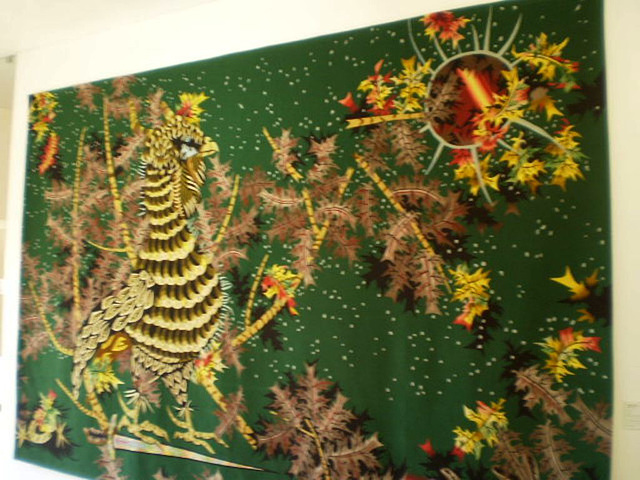
Portalegre
Crato Door (13th century).
Old access to Paço Square, Portalegre.
Devesa Door (13th to 14th century).
Seen from Luís de Camões Street, Portalegre.
Wall tapestry, after painting by Jean Lurçat.
This is displayed in the Portalegre Tapestry Museum (former Convent of Saint Francis). The tapestry of Portalegre was created in 1947, using node points conceived by Manuel Peixeiro, who had been student of textiles at Roubaix, France. Such nodes allowed to reproduce paintings with great accuracy, including colours, chosen among 700 possibilities (or up to 1200, in more difficult works). Such tapestries are ordered by the painters themselves, or with their agreement. The painters tell how many copies can be issued (5, 6, 10) and check the quality of the work before it is released. Each dm2 of the tapestry has between 2,500 and 10,000 node points (authentic textile pixels), applied with the right colours in the right places according to the painting reproduced.
The first tapestry was achieved in 1948 but international acceptance only occurred in 1952, when Jean Lurçat was suggested to tell, between a French tapestry and an authorized "copy" achieved in Portalegre, which he believed to be the French one, and he pointed the one from Portalegre.
Many painters decided to order replicas of their works in Portalegre tapestry, which can be found in private collections and many institutions, like the European Justice Court (Luxemburg), the Government of Bad-Württemberg (Germany) and the Supreme Court of New South Wales (Australia).
Wall tapestry of Portalegre, after "Diana", painting by João Tavares.
Displayed in the Portalegre Tapestry Museum (former Convent of Saint Francis). This kind of tapestry has an exclusive purpose of reproduce paintings, ordered or authorized by their authors.
Wall tapestry of Portalegre, after the painting "Mar Tenebroso", by Costa Pinheiro.
Displayed in the Portalegre Tapestry Museum (former Convent of Saint Francis). This kind of tapestry has an exclusive purpose of reproduce paintings, ordered or authorized by their authors.
Wall tapestry of Portalegre, after a painting by Carlos Botelho.
Displayed in the Portalegre Tapestry Museum (former Convent of Saint Francis). This kind of tapestry has an exclusive purpose of reproduce paintings, ordered or authorized by their authors.
Wall tapestry after "Integração Racial", a painting by Almada Negreiros.
Displayed in the Portalegre Tapestry Museum (former Convent of Saint Francis). This kind of tapestry has an exclusive purpose of reproduce paintings, ordered or authorized by their authors.
Old maple (1838).
Still standing at Rossio, Portalegre. Its long branches have to be supported with "crutches" to prevent them from breaking.
Old Post Office.
At Dr. José Frederico Laranjo Square, Portalegre.
Jump to top
RSS feed- Latest items - Subscribe to the latest items added to this album
- ipernity © 2007-2025
- Help & Contact
|
Club news
|
About ipernity
|
History |
ipernity Club & Prices |
Guide of good conduct
Donate | Group guidelines | Privacy policy | Terms of use | Statutes | In memoria -
Facebook
Twitter










